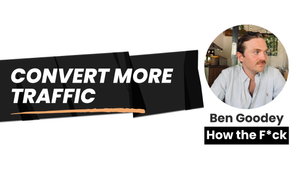10 tips ways to make your audience feel & convert.
Conversion is as much an art as science.
Choosing to take meaningful action, like signing up for a new product or reaching out to a salesperson, is a deeply psychological and mostly unconscious thing.
People's process is often unclear—the brain collects information and when it feels confident it makes the decision...before we consciously know why.
Ask someone why and they'll likely make up a logical reason. But what's clear is that the decision was, at its core, feeling-driven.
You need to feel to decide:
"You should just assume that all decisions involve emotions. Rather than just making logical arguments to persuade, you are more likely to persuade people to take an action if you understand how they are feeling about the decision and feed their feeling. For example, if Kelly is feeling apprehensive about making a wrong decision then your messaging should be more about making her feel secure and safe than it is about product features."—Susan Weinschenk, Ph.D.in Psychology
So, in this week's newsletter, I want to take a look at some of the things that make people "feel" in a way that helps their brain make decisions.
Let's dive in.
1/ Knowing your reader (and showing them)
Step 1: Have empathy for your reader.
Step 2: Show them.
Truly understanding your reader is core to conversion because it helps you build content that will resonate.
You need to “show them you know them” to grab their attention, build trust, and become their guide through solving their pain point.
Before you write your next blog post:
- Read up on Search Mindset
- Think about who is searching that keyword.
- What caused them to search?
- What are they frustrated about?
- What else is going on in their world?
Then create content that displays deep empathy for them.
One of my favourite ways to "show them you know them" is to mirror back their pain point in the introduction.
If you can describe your reader’s problem back to them better than they even know it, and I guarantee you make them “feel” like you’re someone who's deserving of their attention.
2/ Building trust with integrity
People buy from people they like and trust.
But the thing about trust is that it takes years to build, and minutes to break.
Everything I mention in this newsletter today should help you build trust with your readers.
So instead, I’ll focus on five examples of things that erode a feeling of integrity:
- Bait & switch content: A headline that promises one thing, and content that does quite the opposite.
- Bad talking competitors: A product listicle which talks all about why competitors suck OR misrepresents their features to make you look good.
- Basic errors: Things like obvious spelling and grammar mistakes. But also things like keyword stuffing, content spinning, or most AI content pretending it’s not AI.
- Basic content: So many companies out there target senior-level audiences, like Founders, CEOs, CFOs, etc. with incredibly basic and substance-less content. It shows a real lack of understanding of your reader and their needs.
- Avoiding “copy hacks”: So many marketers think they’re being smart using copywriting “tricks”. I think it’s pretty obvious and makes me not trust the writer so quickly.
Content marketing is ultimately about building trust and affinity.
But as soon as you do anything that breaks your integrity, your "feelings of goodwill" bank account empties almost immediately.
3/ Being as authentic as possible
One way to elicit feelings of both trust and intrigue is to be authentic as hell.
- Tell a story from your real life
- Don’t pretend to have 20 years experience if you don’t
- Be honest about your own feelings as you write a subject
- Inject your personality and opinions into the writing
If you can’t be authentic, speak from a place of confidence AND write about a topic, you probably need to:
- Talk to an expert
- Do a lot more research
- Talk to your target audience more
When reading an article, if the author doesn’t show up authentically it makes the piece very “meh”.
Basic advice. Often wrong advice. And ultimately, it’s really obvious you're pretending.
But when they do the opposite?
It’s like a breath of fresh air and, at least for me, quickly elicits trust and intrigue in the company behind the article.
4/ Telling more stories
I’m gonna be honest, I’m not the best storyteller.
I don’t know the techniques of scriptwriters. And I don’t know much about how to weave ancient storytelling methods into business content.
Learning that is part of my mission this year—because stories are memorable.
They make us feel. They're core to who we are as humans.
Despite not being an expert, I strongly encourage writers who work for me to build certain things into their content that you might consider “storytelling”:
- Examples: Always give an example to complicate statements or points. An example takes a point from “we all think we know what you mean” to the more explicit “we all actually know what you mean”. It clears up assumptions and it's more helpful to readers.
- Opinions: “do this” and “don’t do that” is a surprisingly powerful and confident part of an article. It shows you know the subject enough to have an opinion, and if you can explain why someone should trust your opinion, even better. That alone tells a story of your leadership in the topic.
- Personality: There’s always room for a bit more personality in content. People buy from people. So I think it’s really important, and much more interesting, to be able to understand who the author really is. Your corporate writing voice isn’t building an audience anytime soon.
- Angles: I’m a big proponent that all content should have an angle. An angle tells the story of why you’re writing this article, why you, why now, and what makes this piece a unique read. For example, my team wrote a piece for a client recently on “meeting scheduling software for 1-1s” and instead of just listing scheduling tools, we argued that scheduling tools alone aren't enough to deliver the desired outcome. Instead you need a different type of software that does scheduling but also enables better, more productive 1-1 conversations. We also gave them what they initially wanted, but also introduced better options as alternatives, which helped us display expertise while framing our own software as a more complete solution.
5/ Five conversion essentials
This newsletter would be remiss without mentioning these tried and tested conversion fundamentals.
Funnily enough, I still feel most content is missing these:
- Sell the promised land: Most content still talks all about features. But really, people want an outcome, not a feature. It's still important to talk about how your product works, but you must connect the dots for them: “Feature → Benefit → Life afterwards”.
- Social proof: Trying to sell your services or software without social proof? Stop right now. Go get some relevant logos, quotes, and results from your customers. Put them in your content. Use them to build trust and FOMO.
- Design & experience: A poorly designed website, with cheap-looking templates and confusing layouts…is a no from me. I’ve got checklists galore on this if you want help designing your blog experience.
- Call to actions: Every blog post should have a logical, compelling next step. What action do you want the reader to take after reading? Do you have content in place, like a landing page, template, or another blog post for them to continue their journey? Great. Then you need to really sell that next step with a clear CTA that has an offer built into it.
- Clarity: Most content uses overly complex language. Long run-on sentences. And too much industry jargon. If someone can’t understand what you do, they will never convert. So keep things simple, concise, and clear.
A final note that I think is important to mention: none of this is about getting people to buy something they don't want or need. It's about being authentic, avoiding the hacks, and focusing on helping your reader. The more genuine you can be about that, the more effective it often is.
—Benny ✌️


